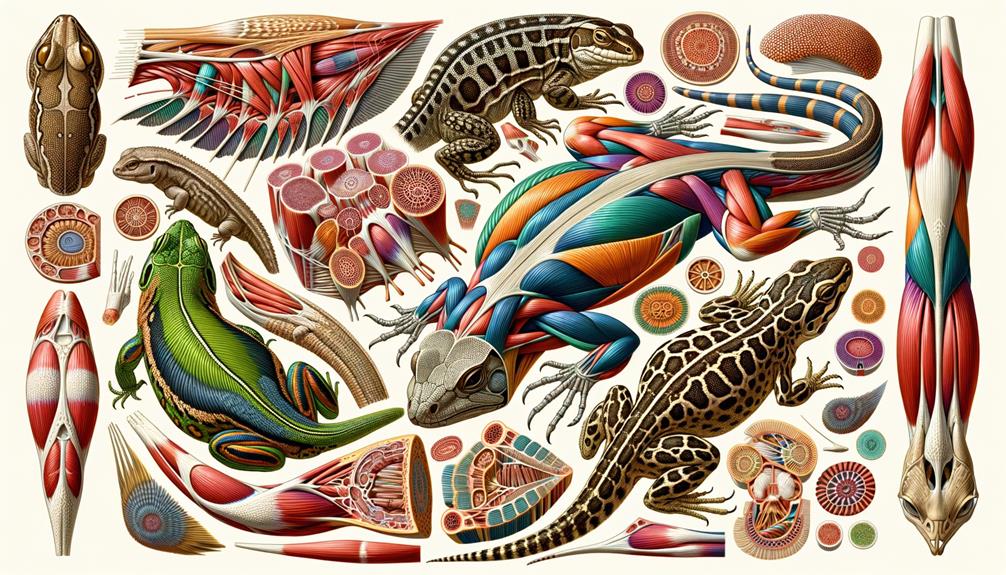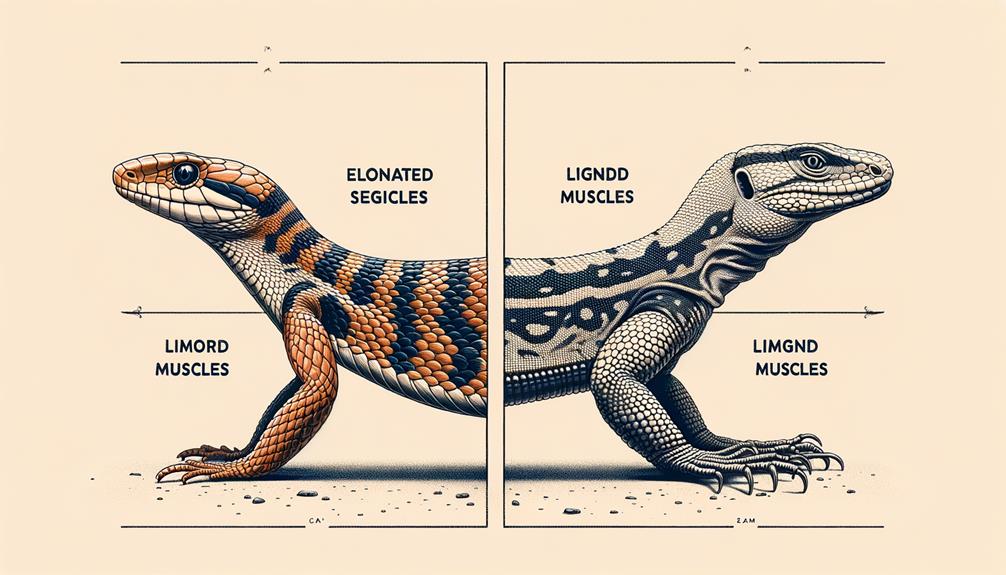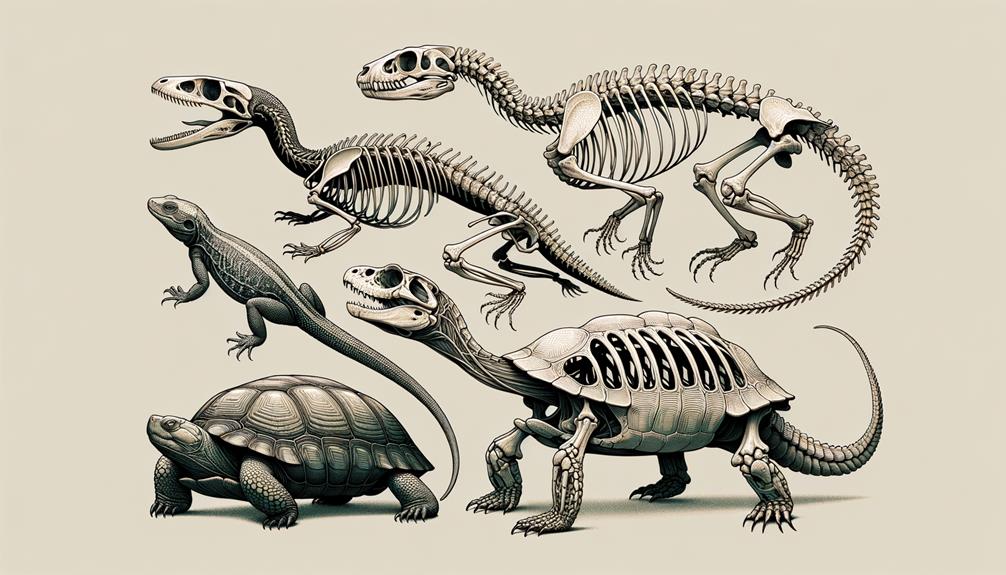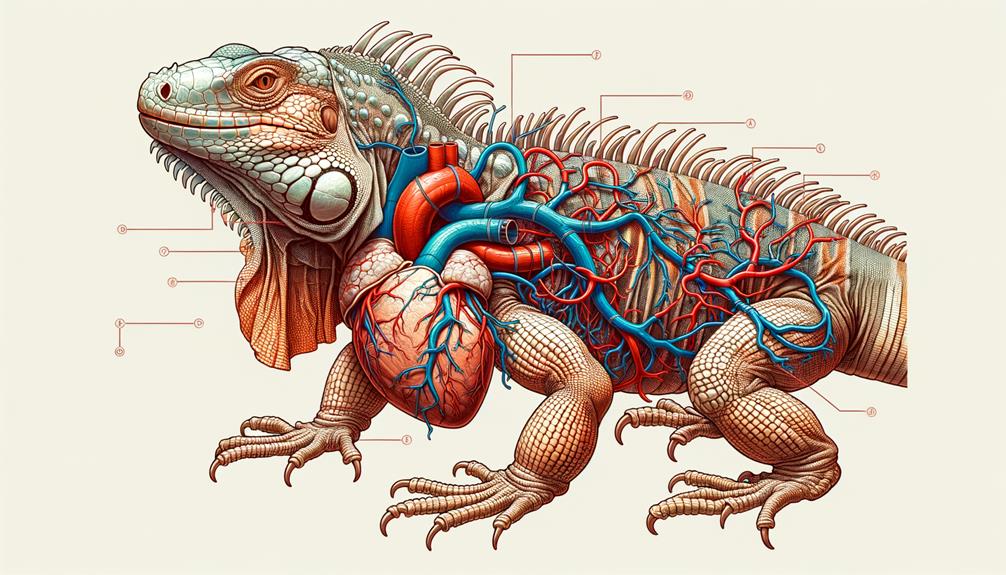Reptiles have evolved remarkable muscular system adaptations that enable them to thrive in diverse environments. Their primary reliance on slow-twitch, fatigue-resistant muscles aligns well with their need for prolonged activities. Unlike mammals, reptiles rely more heavily on anaerobic glycolysis, which supports their muscular endurance. Snakes, for example, possess an astonishing 15,000 muscles, allowing for incredible acceleration and complex locomotion. The epaxial muscles in snakes play a crucial role in striking and traversing terrain. Notably, reptiles' muscle fibers have lower myoglobin content, contributing to their unique energy dynamics. These adaptations underscore their evolutionary success and offer valuable insights into their survival strategies.
Key Takeaways
Reptiles have evolved a unique muscular system that enables them to conserve energy while moving efficiently. Their muscles are composed of a high proportion of slow-twitch, fatigue-resistant fibers, allowing them to sustain long periods of activity without exhaustion.
Unlike other animals, reptiles primarily rely on anaerobic glycolysis to generate energy, which is made possible by their lower myoglobin and mitochondrial density. This adaptation allows them to thrive in environments where oxygen is scarce.
Snakes, in particular, have developed epaxial muscles that are crucial for their movement and striking abilities. These muscles play a vital role in their ability to constrict and capture prey.
Reptiles have also developed remarkable thermoregulatory abilities, using behavioral adaptations to regulate their body temperature. By basking in the sun or seeking shade, they can maintain an optimal body temperature, which is essential for their survival.
The unique characteristics of reptile muscle fibers have allowed them to thrive in diverse environments, from the hottest deserts to the coolest oceans. By balancing energy efficiency with functional demands, reptiles have evolved to occupy a wide range of ecological niches.
Snake Muscular Structure
Snakes possess a remarkable muscular structure that grants them extraordinary agility and precision. Unlike humans, who have around 700-800 muscles, snakes boast an astonishing 10,000-15,000 muscles. This vast number allows them to exert remarkable control over their bodies.
The epaxial muscles, the three largest muscle groups in snakes, play a crucial role in their movement and striking ability. When a snake strikes, it can accelerate at an incredible rate, reaching forces up to 30G. This is roughly three times the limit that even highly-trained pilots can withstand. The snake's specialized muscle arrangement and density are directly responsible for this impressive force.
Some species, like the king snake, can exert astonishing pressure – up to 180 mm Hg. This is sufficient to stop a human heart, demonstrating the immense power housed within their slender bodies. Understanding these muscular adaptations provides valuable insight into how snakes navigate and dominate their environments, showcasing a remarkable level of freedom and control that is both awe-inspiring and scientifically fascinating.
Locomotion Mechanisms

When examining reptilian locomotion, it's essential to look at the efficiency of limb movements and the diversity of muscle fiber types. Reptiles have developed a range of locomotor strategies, from the rapid, coordinated limb movements of lizards to the intricate undulations of snakes. By understanding the specific muscle fibers involved, such as fast-twitch and slow-twitch, we can see how these creatures achieve their remarkable agility and endurance.
Limb Movement Efficiency
Through detailed anatomical studies, we've gained insight into the distinct muscular adaptations of arboreal and aquatic snakes. These adaptations enable them to optimize their locomotion efficiency in their respective environments. For instance, arboreal snakes have evolved longer muscles and tendons that span multiple segments of the vertebral column. This unique architecture allows them to traverse gaps between branches with ease, providing the flexibility and reach necessary to navigate complex, three-dimensional arboreal habitats.
In contrast, aquatic snakes have developed relatively heavier semispinalis-spinalis and longissimus dorsi muscles with a greater cross-sectional area. These robust muscles facilitate more forceful movements, enabling the snakes to propel themselves effectively through the dense, viscous aquatic environment. Our analysis reveals that overall body size and muscle robustness are key factors distinguishing these species, with aquatic specialists showcasing more pronounced adaptations.
Phylogenetic analysis confirms that these differences in muscle architecture are evolutionary adaptations rather than mere phylogenetic artifacts. The interactions between body size and ecological specialization indicate a differential scaling of muscle architecture, particularly evident in aquatic species. This specialized muscle development underscores the critical role of efficient limb movement in the survival and ecological success of these reptiles.
Muscle Fiber Types
Understanding reptiles' muscle fiber types helps us appreciate how their muscular systems are fine-tuned for specialized locomotion. Reptiles exhibit a fascinating diversity in muscle fiber types, with slow-twitch oxidative fibers enabling sustained movements and fast-twitch glycolytic fibers providing rapid, powerful bursts. This differentiation is crucial for their varied locomotor behaviors, from the slow, deliberate movements of a stalking predator to the quick, explosive strikes of a defensive maneuver.
The axial musculature of reptiles, including muscles along the spine, shows remarkable adaptations. For example, arboreal snake species have longer muscles and tendons that span multiple vertebral segments, allowing them to effectively bridge gaps while climbing. In contrast, aquatic snakes have developed relatively heavier semispinalis-spinalis muscles with greater cross-sectional areas, enabling them to generate the force needed for effective swimming in dense aquatic environments.
The longissimus dorsi muscles in aquatic snakes are significantly larger compared to their terrestrial and arboreal counterparts, underscoring their specialization for aquatic locomotion. Phylogenetic analyses confirm that these variations in muscle architecture are evolutionary responses to the demands of different habitats and behaviors, illustrating the intricate relationship between muscle fiber types and reptilian locomotion.
Predatory Adaptations

Snakes have evolved extraordinary muscular adaptations that make them highly efficient predators. Their powerful coils and rapid strike acceleration are made possible by their large epaxial muscles, which play a crucial role in their ability to move and hunt. These muscles enable snakes to exert a squeeze pressure of up to 180 mm Hg, strong enough to stop a human heart.
Snakes can also move at astonishing speeds, thanks to their 10,000-15,000 muscles, which far surpass the 700-800 muscles found in humans. Their strike acceleration can reach up to 30G, exceeding the tolerance of even the most highly-trained pilots. This rapid strike allows them to capture prey with precision and swiftness.
The arrangement and size of these major epaxial muscles provide not only power but also the flexibility and control needed for intricate movements. Whether they're stalking silently or delivering a swift, deadly strike, these muscular adaptations ensure that snakes remain at the top of the predatory hierarchy, demonstrating nature's relentless drive for survival and dominance.
Muscle Fiber Variations

Reptile muscle fiber variations reveal fascinating adaptations that are closely tied to their ecological niches. Snakes, for instance, have epaxial muscles that show significant regional differences in properties like cross-sectional area and lever arm orientation. These differences are highly specialized and are linked to their lifestyle. Arboreal snakes, for example, have longer epaxial muscles that span a greater number of vertebrae, allowing for enhanced flexibility and maneuverability among branches.
On the other hand, aquatic snake species have heavier and more robust semispinalis-spinalis and longissimus dorsi muscles. This muscle architecture is crucial for powerful swimming strokes and efficient propulsion in water. The increased cross-sectional area in these muscles generates greater force, compensating for the resistance encountered in aquatic environments.
The number of vertebrae spanned by these muscles and the overall muscle length are critical factors in defining these adaptations. Phylogenetic analysis shows that these differences in muscle architecture are evolutionary responses to distinct locomotor demands. Interestingly, interactions between body size and habitat further influence these adaptations, with larger species showing more pronounced variations. This intricate relationship between muscle fiber variations and ecological specialization highlights the remarkable adaptability of reptilian musculature.
Comparative Physiology

When comparing muscle fiber types in reptiles and humans, I notice significant differences that give snakes an edge in locomotion efficiency. Snakes' muscle fibers are highly specialized, allowing for rapid acceleration and remarkable endurance. Additionally, reptiles have evolved mechanisms to regulate their body temperature, which enables optimal muscle performance across a wide range of temperatures.
Muscle Fiber Types
Reptiles' muscle fibers have some fascinating adaptations that support their unique way of moving and regulating their body temperature. For example, they have a high proportion of slow-twitch, fatigue-resistant fibers. These fibers are crucial for the longissimus dorsi muscle, which is essential for the lateral undulation movement that many reptiles use.
One key characteristic of reptiles' muscle fibers is that they have lower myoglobin content and mitochondrial density compared to mammals and birds. This is because reptiles rely on anaerobic glycolysis for energy production, which is well-suited to their ectothermic nature. As a result, they can maintain muscular activity without the high metabolic demands seen in endothermic vertebrates.
The slow contractile properties of reptiles' muscles also align well with their need for behavioral thermoregulation. This allows them to remain active or still for long periods as they adjust to environmental temperatures.
Here's a comparison of reptiles, mammals, and birds:
| Feature | Reptiles | Mammals and Birds |
|---|---|---|
| Predominant Fiber Type | Slow-twitch, fatigue-resistant | Fast-twitch, fatigue-prone |
| Myoglobin Content | Lower | Higher |
| Mitochondrial Density | Lower | Higher |
These adaptations are central to reptiles' unique locomotor patterns and highlight the physiological trade-offs that allow them to thrive in diverse environments. By understanding these muscle fiber characteristics, we can gain insight into the evolutionary strategies that have enabled reptiles to survive and succeed.
Locomotion Efficiency
Snakes are incredibly efficient movers, thanks to their massive number of muscles and specialized physiological features. With around 10,000 to 15,000 muscles distributed along their bodies, snakes can achieve remarkable speeds and forces that far exceed human capabilities. For instance, they can accelerate at an astonishing 30G, three times the 10G limit that even highly trained pilots can withstand.
The muscular structure of snakes allows them to lift significant portions of their bodies off the ground, enabling them to glide and strike with ease. This same musculature also generates a squeezing pressure of 180 mm Hg, strong enough to stop a human heart. The power generated along their bodies enables snakes to use energy efficiently and maximize their predatory and evasive maneuvers.
When you compare the physiology of snakes to human muscular capabilities, it's clear that snakes have evolved for efficient locomotion. Their higher muscle count and ability to sustain and exert extreme forces demonstrate a body design optimized for both speed and strength. This efficiency in movement and force application gives snakes a significant edge in their ecological niches, showcasing nature's ingenuity in muscular adaptation.
Thermal Regulation Mechanisms
Reptiles have evolved impressive thermal regulation mechanisms to thrive in diverse environments. As ectotherms, they rely on external heat sources to manage their body temperature, making the resources available in their habitats vital for survival. Basking behaviors are crucial; by absorbing heat from the sun or warm surfaces, reptiles can elevate their body temperature to ideal levels for metabolic processes.
To avoid excessive heat or cold, reptiles seek shade, burrows, or other shelters. These behavioral adaptations allow them to effectively exploit microhabitats, maintaining a stable internal environment despite fluctuating external temperatures. Some species employ a physiological trick called countercurrent heat exchange in their circulatory systems, which helps conserve heat and minimizes thermal loss.
Postural changes also play a significant role in thermoregulation. By altering their body orientation relative to the sun, reptiles can control heat absorption and dissipation with remarkable precision. These thermal regulation mechanisms demonstrate the intricate ways in which reptiles interact with their environments, showcasing a blend of physiological and behavioral strategies that allow them to excel in diverse ecological niches.
Evolutionary Significance

The shift from amphibians to reptiles marked a significant turning point in adapting to life on land. This transformation allowed reptiles to access new food sources and habitats by reducing their reliance on water. One notable adaptation is the development of tough keratin scales, which provided a barrier against dehydration and gave reptiles a clear advantage over their amphibian ancestors.
Reptiles also developed the ability to regulate their body temperature through behavioral means, such as basking in the sun or seeking shade. This enabled them to inhabit a wider range of environments, from arid deserts to temperate forests. Additionally, the evolution of more efficient lungs and a three-chambered heart improved their respiration and circulation, allowing for a more active lifestyle on land.
Reptiles' enlarged brains and enhanced sensory capabilities likely contributed to their evolutionary success. These advancements improved their ability to hunt, evade predators, and interact with their environment. The muscular system adaptations in reptiles were also crucial to their evolutionary journey, enabling them to thrive in diverse terrestrial ecosystems.
Frequently Asked Questions
Do Reptiles Have a Muscular System?
Reptiles have a muscular system that's highly adapted to their ectothermic lifestyle. They possess thousands of muscles that enable various movements, postures, and feeding behaviors. This system allows them to function efficiently with lower energy inputs.
What Is the Function of the Muscles in a Snake?
Snakes' muscles allow them to move rapidly, strike with power, and constrict effectively. The epaxial muscles, crucial for locomotion, enable snakes to generate forces beyond human capabilities, such as accelerating at an incredible 30G.
Do Snakes Have Pectoral Muscles?
Snakes don't need pectoral muscles because their bodies are designed for slithering. They've evolved to rely on their powerful axial muscles for movement, which gives them incredible agility and freedom.
What Is the Axial Musculature of a Reptile?
The axial musculature of a reptile is primarily composed of epaxial muscles, which play a vital role in various movements. These muscles come in different sizes, lengths, and cross-sectional areas, adapting to specific environments, such as land, water, and trees.



